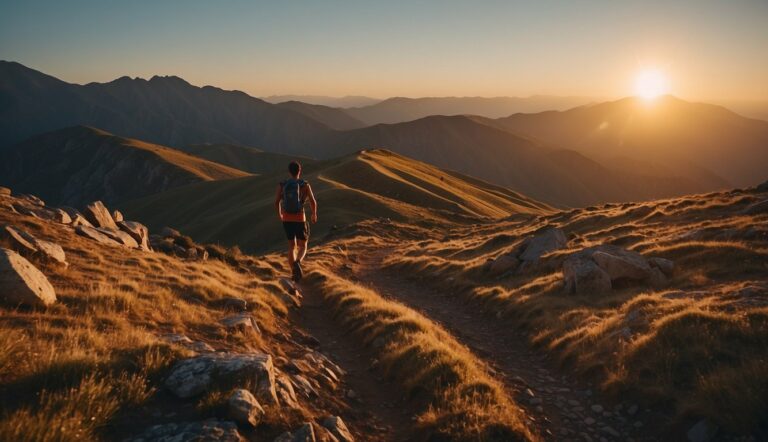How to Choose and Use GPS Devices for Trail Running: Your Essential Guide
Selecting the right GPS device for trail running ensures accurate tracking of your route, distance, and elevation gain, which is crucial for effectively navigating and improving your performance. These watches offer a range of features such as connectivity to multiple satellite systems, including GPS, Glonass, and Galileo, to provide precise location details even in remote areas. A good trail running GPS device should at least support these three satellite systems.
As a UESCA certified running coach, I rely on a GPS watch with a barometric altimeter for elevation data and one that can be synchronized with other fitness devices, like heart rate monitors. It’s essential to use a device compatible with additional sensors to get comprehensive performance data. Moreover, ease of use is just as important; having a watch with a trail-running mode can automatically display relevant metrics like pace, cadence, and altitude changes.
When you’re out on the trail, your GPS should be your steadfast companion. I always ensure the battery life is sufficient for my longest runs and advise against solely relying on smartphones due to their limited battery life under continuous GPS usage. Proper navigation skills coupled with a reliable GPS device empower you to venture with confidence, knowing you have the tools to chart your course and return safely.
GPS Devices for Trail Runners – An Overview
In trail running, selecting the right GPS device is essential for navigation and safety. I’ll help unpack the GPS device fundamentals, compare devices, and consider whether a smartphone can suffice.
Technology Fundamentals
GPS devices operate on a simple principle: they communicate with satellites to pinpoint your exact location on the planet. This technology ensures I can navigate through trails and monitor my run with precision. Key features to look for in a GPS device include durability, water resistance, long battery life, and a clear display.

Types of GPS Devices
When it comes to GPS devices for trail running, it’s not one-size-fits-all. Hand-held units are robust and reliable, often coming with extra features like topographic maps. GPS watches are another type; they offer the convenience of wrist-worn portability and typically include fitness tracking metrics. Here’s a quick comparison:
| Feature | Hand-held GPS | GPS Watch |
|---|---|---|
| Portability | Less portable, varied sizes | Highly portable, wearable |
| Display | Larger screens | Smaller displays |
| Battery Life | Generally longer | Shorter due to compact size |
| Additional Features | Topographic maps, waypoint marking | Fitness tracking, heart rate monitors |
GPS Device vs. Smartphone
While smartphones have GPS functions, they may not be as reliable for trail running as a dedicated GPS device. Their battery life can be shorter, and they are often less durable. Crucially, smartphones depend on a cellular signal for many of their navigational aids—something that may be lacking in remote areas where dedicated GPS devices can still operate effectively.
By using a dedicated GPS device with features like strong battery life and water resistance, I can ensure that I stay on track and safe during my trail runs, regardless of cell service.
Key Features to Consider
When choosing a GPS device for trail running, focus on features that enhance accuracy, extend battery life, and ensure durability. A reliable and user-friendly interface is also crucial for the unpredictable environments you’ll encounter.
Accuracy and Reliability
GPS devices with multi-satellite compatibility (e.g., GPS, GLONASS, Galileo) offer better accuracy. For consistent reliability, choose devices that provide a clear signal in various terrains without constant recalibrations.
- Satellite Networks: A mix of GPS, GLONASS, Galileo for optimal coverage
- Signal Stability: Minimal signal loss for uninterrupted tracking
Battery Life and Power Options
Battery longevity is essential. GPS devices with a battery life that matches or exceeds your longest runs prevent mid-activity power loss. Some options include USB rechargeability or replaceable batteries.
- Battery: Lasts for the duration of your longest planned run
- Charging: USB recharging or the option to replace batteries on the go
Weight and Size
The ideal GPS device should be lightweight and compact, not hindering your performance. A bulky device can impede motion, and every ounce matters in trail running.
- Weight: As light as possible without sacrificing other key features
- Size: Small enough to wear comfortably but with a screen large enough to read easily
Durability and Weather Resistance
Trail running GPS devices must be rugged and weatherproof to withstand harsh conditions. Look for waterproof ratings like IPX7 and scratch-resistant materials.
- Build: Rugged and able to absorb shocks from drops
- Weatherproofing: Waterproof, ideally to a rating of IPX7 or higher
Navigation Tools and Enhancement
In my experience as a UESCA certified running coach, effective use of navigation tools can significantly enhance trail running experiences. These tools help ensure accuracy in navigation and safety on unfamiliar trails.
Mapping and Routes
I always remind runners to familiarize themselves with their route using detailed maps before heading out. A quality GPS device will provide accurate maps that can highlight trails, landmarks, and elevation changes. For enhanced clarity, some devices offer topographic maps with graphical representations of terrain.
- Maps: Should offer clear trail paths and landmarks.
- Routes: Must be preloaded or able to be set up before the run.
Altimeter, Barometer, and Compass
Having an altimeter on a GPS device aids in assessing elevation gain, which is especially useful in trail running to gauge effort and progress. A barometer can help predict weather changes, adding a layer of safety. A built-in compass, not reliant on satellite, is essential for direction finding when GPS signals are weak or unavailable.
- Altimeter: Measures elevation to assess climbs and descents.
- Barometer: Predict atmospheric pressure changes for weather forecasting.
- Compass: Offers directional orientation, independent of satellite signals.
Waypoints and Tracks
I consider waypoints to be personal bookmarks on your route. Marking a waypoint can help you find your way back to a location, like a trailhead or water source. Tracks record your path during a run, allowing you to retrace your steps if needed and analyze your route post-run for improvements.
- Waypoints: Useful for marking important spots.
- Tracks: Automatically record the path taken.
Additional Navigation Aids
In addition to GPS, smartphones or GPS watches can serve as auxiliary navigation aids. However, I advise using them as a complement to a dedicated GPS device due to battery and service limitations. Trail running applications that offer downloadable maps provide a helpful backup.
- GPS watch: Can provide quick glances for pace and distance.
- Smartphone apps: Useful for additional map resources and tracking, if battery life permits.
Integrating GPS with Your Activity
When incorporating GPS technology into your trail running or hiking routine, knowing how to effectively use these devices can enhance your experience in the great outdoors. I’ll cover how to tailor GPS for trail running, manage GPX files for precise navigation, and adapt GPS for various outdoor activities.
Trail Running and Hiking Considerations
For trail runners and hikers, a GPS watch should display real-time data such as location, speed, and distance, which help keep track of performance. Look for devices with:
- Long Battery Life: Essential for prolonged activities.
- Durability: Should withstand rough terrain and weather conditions.
- Comfortable Design: Shouldn’t interfere with movement.
Using GPX Files and Data Tracking
GPX files store routes and waypoints which can be pre-loaded into your GPS device for navigation. Here’s how to use them:
- Download GPX File: Obtain from dedicated trail sites or create your own.
- Load onto Device: Use manufacturer’s software to transfer data.
- Track Your Route: Monitor progress and make sure you’re on the right path.
Additional Outdoor Sports and Activities
Adjacent to trail running, GPS devices also support activities such as biking or kayaking. It’s important to select a multisport GPS watch with modes for different activities. This ensures accurate data tracking for a range of performances. Keep in mind:
- Water Resistance: For water-based activities.
- Barometric Altimeter: For elevation data during mountain sports.
Choosing the Right GPS Device

When trail running, the reliability and functionality of your GPS device are crucial for both navigation and recording your workout. Here’s how to select the best GPS unit that meets your specific trail running needs.
Assessing Your Needs
Firstly, distinguish whether a handheld GPS or a GPS watch suits your style. For quick access and convenience, GPS watches like the Garmin Forerunner series are my go-to.
They track your route, heart rate, and more, all from your wrist. Contrastingly, handheld GPS devices offer more robust navigation features, better suited for those venturing into less traveled areas where detailed mapping is essential.
Comparing Brands and Models
When choosing a brand, Garmin is a leader in GPS technology with a wide range of devices that cater to different preferences. Consider the models’ battery life, durability, satellite connectivity, and extra features like a barometric altimeter or thermometer. Use the following table as a guide:
| Brand/Model | Battery Life | Water Resistance | Added Features |
|---|---|---|---|
| Garmin Fenix | 36+ hours | Yes | Multisport tracking, maps |
| Garmin Forerunner | 24 hours | Yes | Running dynamics, smart notifications |
| Budget Brand X | 18 hours | Varies | Basic tracking |
Considering Budget and Value
The price of a GPS device for hiking and trail running varies widely. For those on a budget, there are affordable options that cover basic tracking needs.
However, investing in a mid-range to high-end model like a Garmin ensures durable quality and a plethora of useful features. Always weigh the initial cost against the longevity and functionality of the device. Here’s a visual to help:
| Price Range | Initial Quality | Long-Term Value |
|---|---|---|
| Affordable | Basic | Lower |
| Mid-Range | Good | Moderate |
| High-End | Excellent | High |
In choosing the right GPS device, consider the types of trails you run, the data you wish to collect, and the ease with which you want to interact with the device._balance this with the price to find the best value for your running career.






